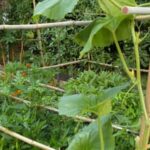Mulching is an essential practice in vegetable gardening that provides numerous benefits, such as conserving soil moisture, suppressing weeds, regulating soil temperature, and improving soil fertility. With a wide variety of mulching materials available, one popular choice among gardeners is wood mulch. However, there are concerns about the safety of using wood mulch in vegetable gardens due to potential chemicals and toxins present in the material.
In this article, we will explore the importance of mulching in vegetable gardens and delve into the world of wood mulch. We will discuss different types of wood mulch available and the benefits they offer for vegetable plants. Furthermore, we will address potential concerns regarding chemicals and toxins that may be present in wood mulch, debunking myths and misconceptions surrounding its safety.
Whether you are new to using wood mulch in your vegetable garden or have doubts about its safety, this article aims to provide you with accurate information and guidance. We will discuss best practices for using wood mulch in vegetable gardens, alternative options to consider, tips for assessing the quality of wood mulch, as well as case studies showcasing successful vegetable gardens utilizing wood mulch.
By the end of this article, you will have valuable insights to make an informed decision on whether or not to use wood mulch in your own vegetable garden.
Stay tuned for our upcoming sections where we dive deeper into understanding wood mulch types and benefits for vegetable gardens, as well as addressing potential concerns surrounding its safety. Let’s explore the fascinating world of mulching together.
Understanding Wood Mulch
Wood mulch is a common and popular choice for vegetable gardens due to its numerous benefits. Understanding the different types of wood mulch available and their specific benefits can help gardeners make informed decisions about which type of wood mulch to use in their vegetable gardens.
There are several types of wood mulch that are commonly used in vegetable gardens, including hardwood bark mulch, cedar mulch, and pine straw. Hardwood bark mulch is made from the outer layer of hardwood trees and is known for being long-lasting and providing good insulation for plant roots. Cedar mulch has a natural insect-repelling quality and can also help suppress weed growth. Pine straw is often used for acidic-loving plants as it can help lower soil pH.
The benefits of using wood mulch in vegetable gardens are plentiful. Firstly, wood mulch helps to conserve moisture by reducing evaporation from the soil surface. This is especially important in vegetable gardens where consistent soil moisture levels are crucial for healthy plant growth. Additionally, wood mulch acts as an insulator, helping to regulate soil temperature by keeping it cooler in hot weather and warmer in cold weather. This ensures optimal conditions for plant root growth and overall productivity.
Another benefit of using wood mulch in vegetable gardens is its ability to suppress weed growth. By creating a barrier between the soil surface and sunlight, wood mulch prevents weed seeds from germinating and emerging. This not only saves time on weeding but also helps minimize competition for nutrients between weeds and vegetables.
Using Wood Mulching: Types and Benefits for Vegetable Gardens
| Type of Wood Mulch | Benefits |
|---|---|
| Hardwood Bark Mulch | – Long-lasting
|
| Cedar Mulch | – Natural insect-repelling quality
|
| Pine Straw | – Suitable for acidic-loving plants
|
Potential Concerns
Wood mulch is a popular choice for vegetable gardens due to its many benefits, such as weed suppression, moisture retention, and improved soil health. However, there are potential concerns regarding the presence of chemicals and toxins in wood mulch that may raise eyebrows among gardeners.
One major concern is the presence of chemical preservatives that are used to treat certain types of wood mulch. These preservatives, such as chromated copper arsenate (CCA) or creosote, are often used to prevent rot and insect damage in wood products. While these preservatives are effective for their intended purposes, they can potentially leach into the soil over time and be absorbed by plant roots.
To address this concern, it is essential to understand the different types of wood mulch available on the market. Some manufacturers now produce mulch made from hardwood that has not been treated with any chemicals. These untreated hardwood mulches provide all the benefits of wood mulch without the potential risks associated with chemical preservatives.
Furthermore, it is important to note that the leaching of chemicals from treated wood mulch is significantly reduced when applied properly. Experts recommend using a layer of landscape fabric or plastic sheeting between the soil and the mulch to provide an additional barrier against any potential leaching. Additionally, regularly monitoring plant health and observing any signs of distress can help identify if any issues arise from chemical exposure.
Is Wood Mulch Safe for Vegetable Gardens? Debunking Myths and Misconceptions
Wood mulch is a common and popular choice for vegetable gardeners looking to improve their soil health, conserve moisture, and suppress weeds. However, there are concerns about the safety of using wood mulch in vegetable gardens due to potential chemicals and toxins. In this section, we will debunk some of the myths and misconceptions surrounding the safety of wood mulch in vegetable gardens.
One common misconception is that wood mulch contains harmful chemicals that can leach into the soil and contaminate vegetables. While it is true that some wood mulches may contain trace amounts of chemicals such as arsenic or creosote, these levels are typically very low and not a cause for concern. Research has shown that the amount of these chemicals that may transfer to plants through mulch is negligible and well below levels considered unsafe for consumption.
Another myth is that wood mulch can introduce harmful pathogens into vegetable gardens. While it is true that certain types of wood chips can harbor fungi or bacteria that could be detrimental to plants, proper composting or heat treatment can mitigate this risk. It is recommended to source wood mulch from reputable suppliers who follow best practices for processing and sterilizing their products.
Furthermore, some gardeners worry about the allelopathic effects of certain trees on vegetable plants. Allelopathy refers to the chemical inhibition or stimulation of one plant by another through the release of substances from roots, leaves, or decomposing matter. While certain trees like black walnut produce compounds that may inhibit the growth of certain plants, most commonly used hardwoods like oak or maple do not have significant allelopathic effects on vegetables.
Best Practices for Using Wood Mulch in Vegetable Gardens
Wood mulch can be a great addition to vegetable gardens when used correctly. It offers numerous benefits such as moisture retention, weed suppression, and temperature regulation. However, it is essential to follow best practices when using wood mulch to ensure the health and safety of your vegetables.
Firstly, it is crucial to choose the right type of wood mulch for your vegetable garden. Hardwood mulch, such as oak or maple, is often preferred over softwood mulch because it decomposes at a slower rate. This means that hardwood mulch will not leach nutrients from the soil as quickly, allowing your vegetables to thrive.
Another important consideration is the size of the wood chips. Smaller wood chips allow for better oxygen and water penetration into the soil. Avoid using large chunks of wood that can create air pockets and hinder water absorption by your plants.
Proper application of wood mulch is key to preventing potential issues in your vegetable garden. Apply a layer of mulch around 2-4 inches thick, ensuring that you leave a gap around the stems of your plants to prevent rotting. Avoid piling up mulch against the plant stems or trunks as this can lead to moisture accumulation and invite pests and diseases.
Furthermore, regular maintenance is necessary when using wood mulch in vegetable gardens. As organic matter breaks down over time, replenish the layer of mulch annually or whenever it becomes thin. This helps maintain moisture levels in the soil and prevents weed growth.
By following these best practices, you can safely incorporate wood mulch into your vegetable garden and enjoy its many benefits.
| Best Practices for Using Wood Mulch |
|---|
| Choose hardwood mulch over softwood |
| Use smaller wood chips for better penetration |
| Apply a layer 2-4 inches thick |
| Leave a gap around plant stems to prevent rotting |
| Maintain regularly by replenishing mulch annually or as needed |
Alternative Mulching Options for Vegetable Gardens
Organic Mulching Options
One alternative to wood mulch for vegetable gardens is organic material, such as straw, hay, or grass clippings. These materials provide many benefits for vegetable gardens. For starters, organic mulch helps retain soil moisture by reducing water evaporation. Additionally, it acts as a natural weed suppressant by blocking sunlight and preventing weed germination. Organic mulch also breaks down over time, adding nutrients to the soil and improving its structure.
However, there are some downsides to using organic mulches in vegetable gardens. Firstly, they can attract pests such as slugs and snails. Proper pest control measures need to be taken when using organic mulch to prevent damage to the vegetables. Secondly, some organic materials may contain weed seeds that could potentially germinate in the garden bed. It is important to ensure that the organic material is properly composted or free from weed seeds before using it as mulch.
Inorganic Mulching Options
Another alternative to wood mulch is inorganic material like landscape fabric or black plastic sheeting. Inorganic mulches offer several advantages for vegetable gardens. These materials create a physical barrier between the soil and sunlight, preventing weed growth effectively. They also allow water and nutrients to pass through while minimizing water evaporation from the soil surface.
Despite these benefits, there are some considerations to keep in mind when using inorganic mulches. One potential issue is that they do not contribute any nutrients back into the soil as they do not break down over time like organic materials. Therefore, regular application of fertilizers may be necessary when using inorganic mulches in vegetable gardens. Additionally, some inorganic materials like black plastic sheeting can become very hot under direct sunlight which may harm plant roots if not adequately managed.
Bio-Degradable Mulching Options
Bio-degradable films made from corn starch or paper are another option for mulching vegetable gardens. These films break down over time, avoiding the need for removal. Bio-degradable mulches offer many benefits such as moisture retention, weed suppression, and protection against soil erosion. They also help regulate soil temperature, keeping it cooler in hot weather and warmer in cold weather.
However, there are a few drawbacks to using bio-degradable mulching options. Firstly, they can be relatively expensive compared to other mulch types. Secondly, some bio-degradable films may take longer to decompose than anticipated, which could affect future planting seasons if not managed properly. It is essential to choose high-quality bio-degradable mulching materials that have a shorter decomposition period to avoid any negative impacts on the garden.
Assessing the Quality of Wood Mulch for Vegetable Gardens
When it comes to choosing the right wood mulch for your vegetable garden, it is essential to assess its quality. The quality of wood mulch can affect the health and productivity of your plants. By understanding what to look for, you can make an informed decision and ensure that you are using a safe and beneficial mulching material.
One important factor to consider when assessing the quality of wood mulch is its source. It is crucial to choose a reputable supplier that uses clean, untreated wood. Avoid using mulch made from old pallets or construction debris as they can contain harmful chemicals or toxins that could be harmful to your vegetables.
Another aspect to consider is the texture and consistency of the mulch. Good-quality wood mulch should have a fine texture with uniform particles. This allows for better moisture retention in the soil and prevents weed growth. Avoid using mulch that has large chunks or uneven pieces, as this can create air gaps and hinder water penetration.
Furthermore, it is essential to evaluate the decomposition rate of the wood mulch. Ideally, you want mulch that decomposes slowly so that it provides long-lasting benefits for your vegetable garden. Mulches with slower decomposition rates will release nutrients gradually into the soil over time, promoting healthy plant growth.
To determine if a wood mulch has a slow decomposition rate, look for hardwood varieties such as oak or cedar. These types of wood take longer to break down compared to softwoods like pine or spruce. Additionally, check if the mulch has been aged properly before using it in your vegetable garden as this process helps accelerate decomposition and reduces competition for nitrogen in the soil.
Tips for Properly Applying and Maintaining Wood Mulch in Vegetable Gardens
Properly applying and maintaining wood mulch in vegetable gardens is essential to ensure its effectiveness and safety. Follow these tips to get the most out of your wood mulch:
- Apply the Right Amount: When it comes to wood mulch, less is more. Apply a layer that is around 2-4 inches thick, making sure not to pile it up against plant stems or tree trunks. This thickness helps prevent weed growth, retain moisture, and regulate soil temperature.
- Choose the Right Type: Not all wood mulches are created equal. Opt for hardwood mulch made from deciduous trees rather than pine or other softwoods. Hardwood mulch decomposes more slowly, providing longer-lasting benefits for your vegetable garden.
- Spread Mulch Evenly: Make sure you distribute the wood mulch evenly across your vegetable garden bed using a rake, hoe, or similar tool. This creates a uniform layer that helps maintain moisture levels throughout the soil.
- Refresh Mulch Regularly: Over time, wood mulch will break down and decompose. Therefore, it’s important to refresh the layer every year or so to replenish its benefits and enhance its appearance in your vegetable garden.
- Monitor Moisture Levels: Wood mulch helps retain moisture but can also prevent excess water from reaching plant roots if applied excessively or incorrectly. Regularly check soil moisture levels and adjust watering as needed to prevent overwatering or underwatering your plants.
- Weed Control: While wood mulch can help suppress weeds by blocking sunlight, some determined weeds may still find their way through the barrier. Regularly inspect your vegetable garden bed for any weed growth and remove them promptly to prevent competition for nutrients and water with your vegetables.
Maintaining wood mulch properly ensures that it will improve the health and productivity of your vegetable garden while minimizing potential concerns associated with its use. By following these tips, you can maximize the benefits of wood mulch and create a thriving environment for your vegetable plants.
Case Studies
Introduction to Case Studies
In this section, we will explore real-life examples of successful vegetable gardens that have used wood mulch as a key component in their gardening practices. By examining these case studies, we can gain insights into the benefits and challenges of using wood mulch in vegetable gardens, and understand how it has contributed to the overall success of these gardens.
Case Study 1: The Smith Family Garden
The Smith family, based in a suburban neighborhood, decided to incorporate wood mulch into their vegetable garden after conducting extensive research on its benefits. They chose a well-aged hardwood mulch made from locally sourced trees. The use of wood mulch helped them create more stable soil moisture levels by reducing evaporation and conserving water. The mulch acted as an insulating layer, moderating soil temperature fluctuations and providing a barrier against weeds.
The Smiths were delighted with the results they achieved using wood mulch. Their vegetable plants thrived due to reduced competition from invasive weeds, resulting in larger yields and healthier produce. Additionally, the wood mulch gradually decomposed over time, enriching the soil with organic matter and improving its structure. This case study demonstrates how proper selection and application of wood mulch can lead to successful vegetable gardening.
Case Study 2: The Johnson Community Garden
The Johnson Community Garden is a collective effort by a group of urban gardeners who prioritize sustainability and eco-friendly practices. They decided to experiment with using recycled shredded bark as their wood mulch choice for their vegetable plots. This type of wood mulch is derived from discarded tree bark obtained from lumber mills or tree care operations.
The use of recycled shredded bark not only saved resources but also provided excellent weed suppression for the Johnson Community Garden’s vegetable crops. The thicker texture of this mulch prevented sunlight from reaching the weed seeds, effectively reducing their germination and growth. Additionally, unlike synthetic mulch options, the recycled shredded bark gradually breaks down over time, adding valuable organic matter to the soil.
The success of the Johnson Community Garden encourages environmentally-conscious gardeners to consider using recycled wood mulch as a sustainable option for promoting healthy vegetable growth while minimizing waste. This case study highlights how different types of wood mulch can be tailored to specific gardening needs and preferences for excellent results.
Case Study 3: The Ramirez Organic Farm
The Ramirez Organic Farm is an example of a larger-scale vegetable operation that utilizes wood chip mulch to foster healthy plant growth while maintaining organic certifications. They specifically choose wood chips from locally sourced trees, ensuring no chemical treatments or pesticides were used during tree maintenance.
By applying a thick layer of wood chip mulch around their vegetable plants, the Ramirez Organic Farm achieved remarkable weed control in their fields. The mulch acted as a physical barrier, preventing sunlight from reaching undesired plants without introducing any harmful toxins into the ecosystem. Moreover, as the wood chips broke down gradually over time, they replenished the soil with essential nutrients and improved moisture retention, enabling robust vegetable growth without relying heavily on synthetic fertilizers or irrigation.
The success of the Ramirez Organic Farm’s extensive use of wood chip mulch demonstrates that it is possible to prioritize organic practices while benefiting from the numerous advantages that wood mulching provides for vegetable gardens. Their case study serves as an inspiration for farmers and commercial growers looking to cultivate high-quality crops sustainably.
Conclusion
In conclusion, when deciding whether or not to use wood mulch in your vegetable garden, it is important to consider the benefits and potential concerns. Wood mulch can provide numerous advantages, such as improving moisture retention, controlling weeds, and enhancing soil fertility. However, it is crucial to be aware of the chemicals and toxins that may be present in certain types of wood mulch.
By debunking myths and misconceptions surrounding the safety of wood mulch in vegetable gardens, we can make more informed decisions. Research has shown that properly sourced and processed wood mulch is generally safe for use in vegetable gardens. It is vital to choose high-quality wood mulch from reputable sources to minimize any potential risks.
Additionally, following best practices for using wood mulch, such as maintaining an appropriate depth and applying it correctly around plants, can help mitigate any negative effects. Alternatively, there are other mulching options available for vegetable gardens that may suit individual preferences or circumstances.
Ultimately, the decision to use wood mulch in your vegetable garden should be based on careful consideration of its benefits and potential drawbacks. By assessing the quality of the wood mulch and employing proper application methods, you can create a successful and thriving vegetable garden while ensuring the safety of your produce. Remember to always prioritize environmental sustainability and choose materials that align with your gardening goals.
Frequently Asked Questions
Is wood mulch OK for vegetable garden?
Wood mulch can be used in a vegetable garden, but there are some considerations to keep in mind. First, it’s important to use aged wood mulch as fresh wood chips can deplete the nitrogen levels in the soil as they break down.
Additionally, it’s best to avoid using wood chips from treated lumber, as these can contain harmful chemicals that may leach into the soil and impact the vegetables. Overall, if you choose the right type of wood mulch and ensure it is properly aged, it can help regulate soil temperature, conserve moisture, and suppress weeds in a vegetable garden.
What type of wood mulch is best for vegetable garden?
When selecting wood mulch for a vegetable garden, it’s important to prioritize natural alternatives such as pine straw or hardwood mulch made from oak or maple. These types of wood mulches are preferable over cedar or cypress since they tend to be more sustainable options.
Pine straw is popular for its ability to break down quickly and enrich the soil with organic matter while also providing good moisture retention properties. Hardwood mulches like oak or maple decompose at a slower rate but offer excellent weed suppression and insulation benefits for vegetable plants.
Is wood mulch good for tomato plants?
Wood mulch can provide numerous benefits for tomato plants when used properly. Mulching around tomato plants with wood chips helps regulate soil temperatures by keeping them cooler during hot summer days and warmer during cooler nights. This aids in maintaining optimal growing conditions for the tomatoes.
Additionally, wood mulch acts as a barrier against weeds that compete with tomato plants for nutrients, light, and water resources. By suppressing weed growth under the mulch layer, tomato plants have better access to these essential resources and can thrive more effectively. Lastly, wood chip mulch aids in retaining moisture in the soil by reducing evaporation rates, preventing excessive drying out of the root zone which is crucial for healthy tomato growth and productivity.

If you’re looking to get into vegetable gardening, or are just looking for some tips on how to make your current garden better, then you’ve come to the right place! My name is Ethel and I have been gardening for years. In this blog, I’m going to share with you some of my best tips on how to create a successful vegetable garden.





